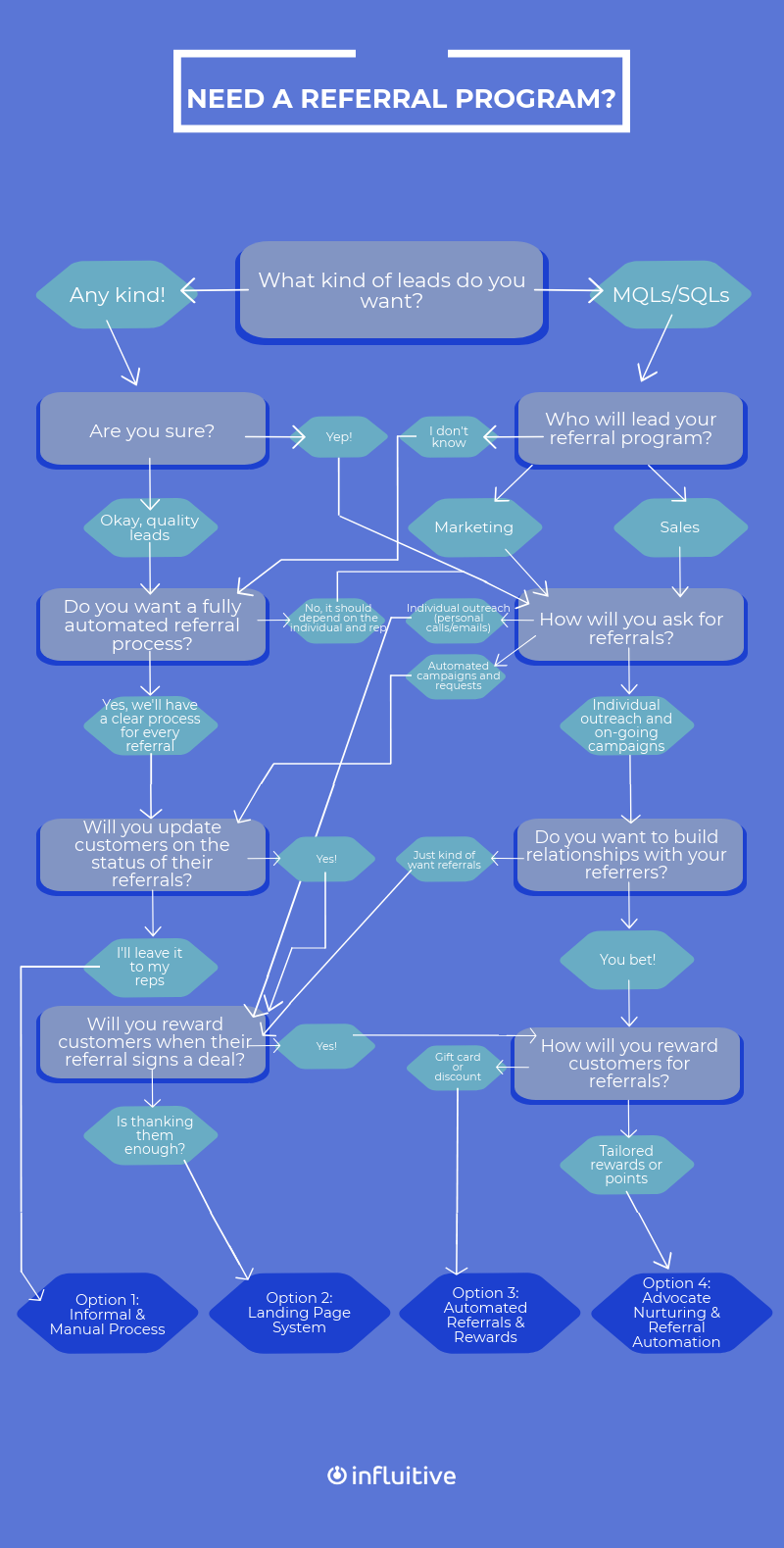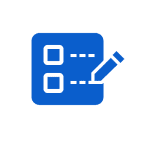There’s a lot of referral program software out there. While some technologies focus on simpler tasks—like tracking and capturing referrals—others have more complex features, like automated rewards and integrations with other tools to create a more seamless experience.
Before digging into your research on platform providers, a helpful exercise is to think about what exactly you’re hoping to achieve with your referral program, and the type of setup that will help support your specific needs.
What are your options for launching a referral program?
Depending on what your goals for your referral program are, and the level of sophistication required from your tech stack, there are a few options you can pursue.

1. Informal and manual process—an ad-hoc referral request method
This strategy relies on manually capturing and tracking referrals. There’s no clear process for requesting referrals, closing the feedback loop, or rewarding customers. Collecting high-quality referrals is also difficult due to a lack of transparency and customer nurturing before and after the referral request is made. Though it would be impossible to scale your program with this approach, it can be a helpful first step to help you evaluate whether referral program software is right for you.
2. Landing page system—a simple home for referral collection
A simple web form allows for easy customer referral submission and internal tracking. The referral data collected from the form is often transferred to a Customer Relationship Management (CRM) platform so it’s accessible to sales/marketing. Reward fulfillment is likely a manual process.
This lack of scalable engagement before and after customers are sent to the referral submission page may cause low-quality submissions.
3. Automated referrals and rewards—an organized referral system
A fully-automated landing page and rewards system that integrates with your CRM allows for efficient referral collection and tracking, automated customer updates (usually via email) on the status of their referrals, and standardized reward fulfillment.
While the internal referral management process is effective, this system lacks a way to personally engage customers at every stage of the referral process—making it tough to consistently receive high-quality referrals.
4. Advocate nurturing and referral automation—an effective and engaging customer referral program
The referral nurturing, submission, feedback, and rewards processes are fully-automated and integrated with an advocate marketing program. A points-based rewards system allows advocates to choose personalized rewards.
This increased engagement throughout the entire referral process results in a continuous stream of new referrals
What should you consider in the buying process?
If you want to build a scalable program that consistently generates high-quality referrals, you’ll probably have surmised that option four is your best bet. When you’re looking into which referral program software might work for your particular goals, here’s a handy checklist of core tools and functionalities you should look out for.
1. CRM integration
If your sales team uses customer relationship management (CRM) software—like Salesforce—then you’ll want to be able to integrate your referral program software with it. This will help you track the progress of a referral through your sales funnel, which will make following up with your customers on the status of their referral easier.
2. A simple way to submit referrals
The solution that you purchase should provide a hassle-free referral submission page where customers can fill out a few customized form fields to refer their peers. There should also be space to outline the referral process and information about the types of referrals you’re looking for. This will help customers feel comfortable submitting high-quality referrals.
3. An easy way to follow up on the status of referrals
Your referral software should offer a convenient way to keep customers up-to-date on the status of their referral, so that they stay motivated to continue referring more of their peers. This can be through automated email updates or a login function. If your program is integrated with your CRM, these status updates should be automatically sent to customers.
4. The ability to nurture customers before and after a referral is submitted
After a customer sends a referral your way, it’s important to nurture that relationship further by recognizing the customer and consistently engaging them so they continue to submit new referrals. While some referral program software solutions can facilitate parts of the nurturing process, integrating your referral solution with an advocate marketing platform allows for the most flexibility when it comes to deeply and consistently engaging customers before and after a referral submission.
5. An automated rewards process
Customers should be thanked and rewarded after a referral is submitted or becomes a new customer so they feel appreciated—and therefore motivated—to refer again in the future. The software you choose should be able to facilitate automatic reward fulfillment.
Vary your redeemable rewards so that you’re not only offering gift cards or discounts—which can lose their appeal the more customers provide you with referrals. A points system works well in that it allows customers to choose their own rewards. You can also set point values based on the quality and frequency of submissions—incentivizing your customers even more.
6. Customer service and support
You may want to prioritize a provider that offers a high level of customer service and support as you develop and launch your program (depending on how much technical expertise you have in-house). They must be able to answer any technical questions or roadblocks you might have. Ideally, they should also help you create an effective strategy for your program based on your business needs and industry.
How do you set a program budget that works for you?
After you’ve come to the conclusion that your organization would benefit from referral program software, then comes the task of getting support from your internal stakeholders—which can be difficult when budgets are tight.
Here are some tips to help you get the most out of your investment in the platform you select, and confidently make your case to executives for the value of the program.
Within your program, there will be three cost elements you’ll need to consider:
- Cost of software: Referral program software solutions can cost hundreds or thousands of dollars a month depending on the size of your organization, so don’t rush the buying process. Take time to carefully evaluate all the features and make a precise plan on how you’ll use the software within your department (the higher ups will appreciate this). A pro tip: read product reviews on several websites—like G2—to see how happy (or unhappy) other users are.
- Cost of rewards: As a general benchmark, offer customers a reward valued at 10% of your average deal size. Multiply this amount by the number of referrals you hope to receive, and their average conversion rate.
- Cost of administration: If you’re investing in software, you’ll see immediate gains in efficiency (compared to spreadsheets and tracking sales people down). As a rule of thumb, ongoing administration of your program should take 30% (or less) of a full-time employee’s time.
Your program ROI should also take into account your average sale price (ASP) and current cost per lead (CPL). One well placed referral could cover the entire cost of your program, depending on your average selling price. Plus, increasing the referrals you receive should also reduce your average cost per lead.













































